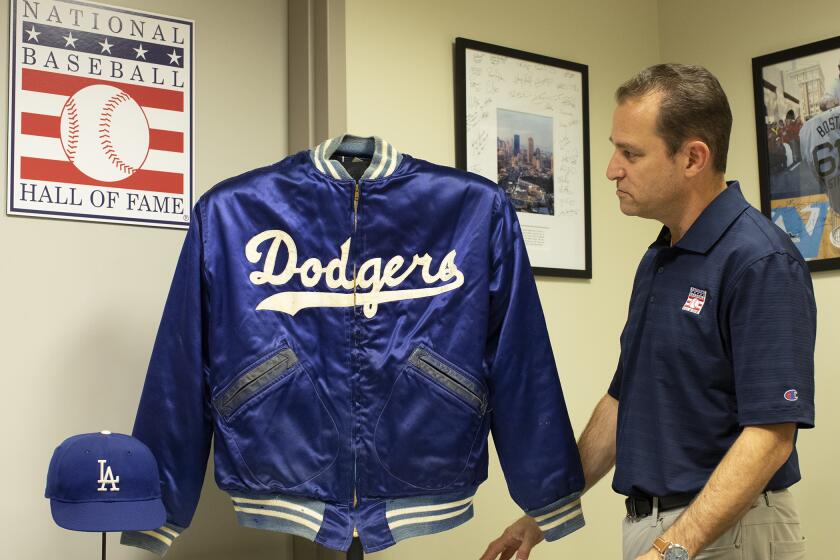Right or Left, It Was Clear It Wasn’t Right
- Share via
It was Sunday morning, deep in the bowels of Dodger Stadium, and team doctor Frank Jobe was explaining the injury that had caused Fernando Valenzuela to be placed on the 21-day disabled list.
“It’s sort of a syndrome,” Jobe said, “but we’re calling it a stretched anterior capsule of the right shoulder.”
“ Left shoulder,” said Dodger trainer Bill Buhler, standing at Jobe’s side.
Whatever.
Those are details best left to the medical men. What’s important to the Dodgers and their fans is:
1. Fernando the Unbreakable and Unshakable, the most durable baseball pitcher of our time, will be lost to the team for at least three weeks, probably more.
2. The mystery has been solved.
After more than a year of the world pondering what’s wrong with Fernando, the world knows.
Valenzuela doesn’t need a diet. He doesn’t need eyeglasses. All he needs is a new right shoulder. Left shoulder. Whatever.
Actually, all he needs is a little R&R;, rest and rehab, or so the doctors believe. Still, there was a subdued air in the Dodger clubhouse when the news spread of Fernando’s impending vacation. This is no ordinary pitcher going on the shelf with an ordinary injury.
This is Fernando, the bull, the rock, the rubber arm, The Iron Caballo.
He has carried the Dodgers colors into battle for 255 consecutive starts, 8 seasons without missing a beat.
How subdued were the Dodgers? Well, Manager Tom Lasorda sat behind his desk and delivered what sounded suspiciously like a eulogy.
Someone mentioned the 255-game streak and Lasorda cued the organ music.
“Quite an accomplishment, quite an accomplishment,” Lasorda said, solemnly. “He was quite a competitor. It’s going to look funny not to see Fernando out there on that hill of thrills. His contributions to the team were tremendous.”
Note the use of past tense? Had somebody misinformed Lasorda? Didn’t Dr. Jobe say it was just the arm that was dead, not the whole Fernando?
Inquiring media minds wanted to know, and went searching for Valenzuela himself. We finally located him in the hallway outside the clubhouse, courageously clinging to life, relaxing on an equipment chest.
“This (being injured) is normal,” Fernando said. “Everybody’s human, I’m human.”
That point now medically certified, what remains to be seen is whether the prescribed R&R; will restore that famous arm to its former splendor. A month or so from now, will we see the old Fernando, or rather, the Fernando of old?
“I hope so, Fernando Present said, laughing. “The way Pat (Screnar, team physical therapist) told me, if I work hard on the weight program, it’s possible it will come back strong again.”
The 255-game streak was mentioned and Fernando said: “I’m very proud to pitch for all those years, go every fifth day, sometimes every four days. But this happened.”
How? Was Fernando foolishly courageous, trying to pitch through the pain? Were the Dodgers at fault for not forcibly strapping Fernando to a polygraph long ago and asking him, “How’s your arm, kid? Your left arm?”
Fernando insisted he didn’t macho himself out of the lineup.
“If I hurt, I don’t pitch anymore,” he said. “At that time (before Saturday), I feel fine.”
And pitch lousy.
Back to Lasorda.
“I always felt that way (that Valenzuela was hurt) but he would never tell you, because he’s such a tremendous competitor,” Lasorda said. “That was one of the tough things. He kept saying there wasn’t anything wrong with him.
“You can’t blame a guy for that.”
Lasorda launched into an anecdote about when he was pitching for the Dodgers in 1955, against the St. Louis Cardinals. He threw a wild pitch, covered the plate and was spiked badly on the right knee by Wally Moon.
Lasorda was gushing from the wound like a Roman fountain, and was risking permanent injury, but doggedly refused to come out of the game.
Dodger coach Bill Russell was listening to the story.
“There’s a little difference between you and Fernando,” Russell pointed out.
“If I pitched against guys like you,” Lasorda sputtered, “I’d’ve been flying around in Lear jets.”
The difference between Lasorda and Valenzuela, for the record, is 118 victories, and counting. Lasorda was 0-4 lifetime, Fernando is 118-90.
The news of Valenzuela came as something of a relief to Lasorda. Tommy was facing the prospect, very soon, of calling Fernando into his office and telling his most game ballplayer he was being removed from the rotation.
Valenzuela had pitched effectively Saturday, until something snapped, crackled or popped, but the Dodger speed gun clocked his fastball--excuse the expression--at between 79 and 82 m.p.h.
You can mix up your pitches with a Cuisinart, dazzle the opposition with control and variety, but if you’re featuring a 79-m.p.h. slowball, be prepared to chuck ‘n duck.
Now when people ask what’s wrong with Fernando, the Dodgers can whip out their Gray’s Anatomy and show diagrams.
Questions remain, however.
When something twanged in Fernando’s shoulder Saturday and he notified the dugout, why did the Dodgers let him pitch to two more batters? Wasn’t this obvious shower time?
Knowing Valenzuela’s heroic nature, yet seeing him falter during the past year, why didn’t the Dodgers long ago spike his Gatorade with truth serum to find out if he was really hurting?
Is the Dodgers’ pitcher of the ‘80s washed up at 27?
Can the Dodgers continue to drive toward a pennant with Fernando sidelined?
If Valenzuela should need surgery, shouldn’t somebody take a grease pencil and write “L” and “R” on the appropriate arms, just to be safe?
More to Read
Are you a true-blue fan?
Get our Dodgers Dugout newsletter for insights, news and much more.
You may occasionally receive promotional content from the Los Angeles Times.










